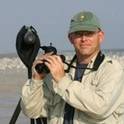
Aim
Avian communities in human-modified landscapes exhibit varying patterns of local colonization and extinction rates, determinants of species occurrence. Our objective was to model these processes to identify habitat features that might enable movements and account for occupancy patterns in habitat matrices between the Guanica and Susua forest reserves. This knowledge is central to conservation design, particularly in ever changing insular landscapes. Location
South-western Puerto Rico. Methods
We used a multiseason occupancy modelling approach to quantify seasonal estimates of occupancy, and colonization and extinction rates of seven resident avian species surveyed over five seasons from January 2010 to June 2011. We modelled parameters by matrix type, expressions of survey station isolation, quality, amount of forest cover and context (embedded in forest patch). Results
Seasonal occupancy remained stable throughout the study for all species, consistent with seasonally constant colonization and extinction probabilities. Occupancy was mediated by matrix type, higher in reserves and forested matrix than in the urban and agricultural matrices. This pattern is in accord with the forest affinities of all but an open-habitat specialist. Puerto Rican Spindalis (Spindalis portoricensis) exhibited high occupancy in the urban matrix, highlighting the adaptability of some insular species to novel environments. Highest colonization rates occurred when perching structures were at ≤ 500 m. Survey stations with at least three fruiting tree species and 61% forest cover exhibited lowest seasonal extinction rates. Main conclusions
Our work identified habitat features that influenced seasonal probabilities of colonization and extinction in a human-modified landscape. Conservation design decisions are better informed with increased knowledge about interpatch distances to improve matrix permeability, and habitat features that increase persistence or continued use of habitat stepping stones. A focus on dynamic processes is valuable because conservation actions directly influence colonization and extinction rates, and thus, a quantitative means to gauge their benefit.
Available at: http://works.bepress.com/stephen_dinsmore/103/

This article is published as Irizarry, Julissa I., Jaime A. Collazo, and Stephen J. Dinsmore. "Occupancy dynamics in human‐modified landscapes in a tropical island: implications for conservation design." Diversity and Distributions 22, no. 4 (2016): 410-421. Doi: 10.1111/ddi.12415.